The Mainstreaming of NBS in the SECAP of San Donà di Piave: The LIFE Master Adapt Methodology
Abstract
1. Introduction
- embrace nature conservation norms and principles;
- can be implemented alone or in an integrated manner with other solutions to societal challenges (e.g., technological and engineering solutions);
- determined by site-specific natural and cultural contexts that include traditional, local and scientific knowledge;
- produce societal benefits fairly and equitably, in a manner that promotes transparency and broad participation;
- maintain biological and cultural diversity and the ability of ecosystems to evolve;
- are applied at a landscape scale;
- recognize and address the trade-offs between the production of a few immediate economic benefits for development and future options for the production of the full range of ecosystem services;
- are an integral part of the overall design of policies and measures or actions, to address a specific challenge.
- Increase and mainstream NBSs within national, regional and local governance;
- Enhance regional cooperation, in ways that encourage ambition, transparency and environmental integrity;
- Generate the shifts needed in both domestic and international governance and finance to realize the potential of NBS;
- Scale-up NBS for mitigation, resilience and adaptation in key areas, ensuring people’s livelihoods in the face of climate threats [29].
2. Materials and Methods
2.1. LIFE Master Adapt
- climate analysis and vulnerability assessment at the regional level to identify climate change impacts, risks and vulnerabilities for key sectors and provide indicators and guidelines for climate analysis and vulnerability assessment at regional and local levels;
- assessment of mainstreaming processes in climate change adaptation practices selected from those already in place at the European level, to create a European network and capitalize on experiences;
- definition of adaptation objectives at the regional and sub-regional level, following a process of vertical and horizontal mainstreaming, by aligning and aligning adaptation policies at different levels;
- developing effective methods for multi-level integration and governance in the definition of regional and sub-regional adaptation strategies;
- integration of the adaptation strategy and the measures identified, at the intermediate administrative level—groups of municipalities and metropolitan cities;
- replicate and transfer project results to other regions and municipalities.
2.2. From LIFE Master Adapt to the Declination in the Municipality of San Donà di Piave
- definition of new information levels and new knowledge levels. This phase was made possible thanks to a climate analysis and a vulnerability assessment which identified impacts, risks and vulnerabilities from climate change for key sectors;
- support for the process that led to the definition of adaptation goals and strategies and then to the actions applied to the territory. This phase took place with a strong process of involvement of local authorities and stakeholders. In the case study, a strong bottom-up process was used which was developed with the contribution of the sectors of the municipality, the political part of the municipality and the CMVe, the scientific partners of the project. The adaptation goals of the area have been defined according to the following step: (1) definition of goals for adaptation, (2) definition of a view for the development of the territory in conditions of climate change, (3) identification of general and specific goals and (4) proposal of possible options to achieve goals;
- definition of nature-based solution and mainstreaming of specific measures in existing plans and programs. This phase was facilitated (1) by a series of training sessions for technicians and municipal administrators who were introduced to the basics of climate-proof planning, climate change, mitigation and adaptation [31], (2) by specific tools which have supported the technicians in mainstreaming, such as the “Guidelines for mainstreaming in groups of municipalities” [32] and (3) with a survey submitted to each municipality and analysis of municipal planning, looking for existing actions that deal, directly or indirectly, with adaptation to climate change. This phase has produced a state of the art and a thorough knowledge of what has already been implemented in the municipality.
3. Results
- Definition of new information levels and new cognitive levels;
- Support for the process which led to the definition of adaptation goals and strategies;
- Definition of nature-based solutions and mainstreaming of specific adaptation measures in existing plans.
3.1. Definition of New Information Levels and New Cognitive Levels
3.2. Support for the Process Which Led to the Definition of Adaptation Goals and Strategies
3.3. Definition of Nature-Based Solution and Mainstreaming of Specific Adaptation Measures in Existing Plans
4. Discussion
- territorial analysis (risk assessment);
- selection of goals linked with European and national strategies;
- definition of nature-based solutions starting from what is already implemented by different actors;
- creation of a single table to bring together actors who are usually used to work separately.
- approach territorial planning by defining goals and implementing actions thanks to a very consistent analysis phase;
- exploit the matrix of adaptation options also for defining the SECAP strategy, creating its strategic vision.
- supporting municipalities in the mainstreaming processes;
- supporting the definition of a free and shared metropolitan knowledge framework (DST);
- training municipal technicians and accompanying the definition of the matrix vision/goals/action that has allowed shared reasoning on a large scale.
5. Conclusions
Author Contributions
Funding
Conflicts of Interest
References
- AAVV. Atlante della Laguna. Venezia tra Terra e Mare; Marsilio: Venice, Italy, 2006. [Google Scholar]
- Sistema Nazionale per la Protezione dell’Ambiente (SNPA). Rapporto “Consumo di Suolo, Dinamiche Territoriali e Servizi Ecosistemici”; SNPA: Rome, Italy, 2019. [Google Scholar]
- Ministero dell’Ambiente e della Tutela del Territorio e del Mare (MATTM). Piano Nazionale di Adattamento ai Cambiamenti Climatici PNACC; MATTM: Roma, Italy, 2016. [Google Scholar]
- Antonioli, F. Sea-level rise and potential drowning of the Italian coastal plains: Flooding risk scenarios for 2100. J. Maps 2017, 13, 961–967. [Google Scholar] [CrossRef]
- Indovina, F. La Città Diffusa; Istituto Universitario di Architettura di Venezia, Dipartimento di Analisi Economica E Sociale del Territorio: Venice, Italy, 1990. [Google Scholar]
- EU Climate Change Adaptation Strategy. Available online: www.eur-lex.europa.eu/legal-content/IT/TXT/PDF/?uri=CELEX:52013DC0216&from=EN (accessed on 18 October 2020).
- UNFCC—United Nations Framework Convention on Climate Change. The Paris Agreement. Available online: www.unfccc.int/process-and-meetings/the-paris-agreement/the-paris-agreement (accessed on 28 October 2020).
- CMCC, SNACC—Elements to Develop a National Adaptation Strategy to Climate Change. Available online: www.cmcc.it/projects/snac-elements-to-develop-a-national-adaptation-strategy-to-climate-change (accessed on 11 June 2020).
- The European Green Deal. Available online: www.eur-lex.europa.eu/legal-content/EN/TXT/?qid=1588580774040&uri=CELEX:52019DC0640 (accessed on 10 November 2020).
- European Climate Law. Available online: https://ec.europa.eu/clima/policies/eu-climate-action/law_en (accessed on 10 November 2020).
- The European Green Deal Investment Plan and Just Transition Mechanism. Available online: https://ec.europa.eu/commission/presscorner/detail/en/qanda_20_24 (accessed on 10 November 2020).
- Ministero dell’Ambiente e della Tutela del Territorio e del Mare (MATTM). SNACC—Strategia Nazionale di Adattamento ai Cambiamenti Climatici; MATTM: Rome, Italy, 2014. [Google Scholar]
- Ministero dell’Ambiente e della Tutela del Territorio e del Mare (MATTM). PNACC—Piano Nazionale di Adattamento ai Cambiamenti Climatici; MATTM: Rome, Italy, 2017. [Google Scholar]
- Coronato, M. The Sustainability Dimensions: A Territorialized Approach to Sustainable Development. 2020. Glob. J. Hum.-Soc. Sci. 2020, 20, 23–32. [Google Scholar] [CrossRef]
- Reckien, D.; Salvia, M.; Heidrich, O.; Church, J.M.; Pietrapertosa, F.; de Gregorio-Hurtado, S.; d’Alonzo, V.; Foley, A.; Simoes, S.G.; Lorencová, E.K.; et al. How are cities planning to respond to climate change? Assessment of local climate plans from 885 cities in the EU-28. J. Clean. Prod. 2018, 191, 207–219. [Google Scholar] [CrossRef]
- Bulkeley, H.; Kern, K. Local Government and the Governing of Climate Change in Germany and the UK. Urban Studies 2003, 43, 12. [Google Scholar] [CrossRef]
- Hunt, A.; Watkiss, P. Climate change impacts and adaptation in cities: A review of the literature. Clim. Chang. 2011, 104, 13–49. [Google Scholar] [CrossRef]
- Kousky, C.; Schneider, S.H. Global Climate Policy: Will Cities Lead the Way? Clim. Policy 2003, 145, 1–14. [Google Scholar] [CrossRef]
- Walker, R.V.; Beck, M.B.; Hall, J.W.; Dawson, R.J.; Heidrich, O. The energy-water-food nexus: Strategic analysis of technologies for transforming the urban metabolism April 2014. J. Environ. Manag. 2017, 141, 104–115. [Google Scholar] [CrossRef] [PubMed]
- IPCC. AR5 Synthesis Report: Climate Change 2014; IPCC: Geneva, Switzerland, 2014. [Google Scholar]
- Wamsler, C.; Brink, E.; Rivera, C. Planning for climate change in urban areas: From theory to practice. J. Clean. Prod. 2013, 50, 68–81. [Google Scholar] [CrossRef]
- EU Covenant of Mayors, Plans & Actions. Available online: www.eumayors.eu/plans-and-actions/action-plans.html (accessed on 9 June 2020).
- Businaro, G. Beni Comuni Urbani Per Una Nuova Alleanza Tra Istituzioni E Cittadini. Master’s Thesis, Università Iuav di Venezia, Venice, Italy, 2019. [Google Scholar]
- IUCN. Available online: www.iucn.org (accessed on 7 October 2020).
- Maes, J.; Jacobs, S. Nature-Based Solutions for Europe’s Sustainable Development. Conserv. Lett. 2017, 10, 121–124. [Google Scholar] [CrossRef]
- World Bank. Nature-Based Solutions for Disaster Risk Management; World Bank: Washington, WA, USA, 2018. [Google Scholar]
- Mittermeier, R.A.; Totten, M.; Pennypacker, L.L.; Boltz, F.; Mittermeier, C.G.; Midgley, G.; Rodriguez, C.M.; Prickett, G.; Gascon, C.; Seligmann, P.A.; et al. A Climate for Life: Meeting the Global Challenge; CEMEX Conservation Book Series; CEMEX: Washington, WA, USA, 2008. [Google Scholar]
- Cohen-Shacham, E.; Walters, G.; Janzen, C.; Maginnis, S. Nature-Based Solutions to Address Global Societal Challenges; IUCN: Gland, Switzerland, 2016. [Google Scholar] [CrossRef]
- United Nations Global Compact (UNGC). UN Global Compact Progress Report 2019; UNGC: New York, NY, USA, 2019. [Google Scholar]
- LIFE Master Adapt. Available online: https://masteradapt.eu/ (accessed on 17 April 2020).
- LIFE Master Adapt. Case Study Report (Action C3); LIFE Master Adapt: Cagliari, Italy, 2020. [Google Scholar]
- LIFE Master Adapt. Guidelines for Mainstreaming in Groups of Municipalities (Action C3); LIFE Master Adapt: Cagliari, Italy, 2020. [Google Scholar]
- LIFE Master Adapt. Guidelines, Principles and Standardized Procedures for Climate Analysis and Vulnerability Assessment at the Regional and Local Level within (Action A1); LIFE Master Adapt: Cagliari, Italy, 2020. [Google Scholar]
- LIFE Master Adapt. Climate Analysis and Vulnerability Assessment: Results for the Pilot Region and in the Target Areas of Action C3 (Action A1); LIFE Master Adapt: Cagliari, Italy, 2020. [Google Scholar]
- LIFE Master Adapt. Smart Tools: Interactive Map and Common DSS (Action C3.2); LIFE Master Adapt: Cagliari, Italy, 2020. [Google Scholar]
- LIFE Master Adapt. Policy Guidance for the Definition of Adaptation Objectives at the Regional and Local Level and the Related Governance (Action C1); LIFE Master Adapt: Cagliari, Italy, 2020. [Google Scholar]
- Patto dei Sindaci. Available online: www.pattodeisindaci.eu/ (accessed on 21 June 2020).
- Comune di San Donà di Piave. Piano d’Azione per l’Energia Sostenibile ed il Clima—PAESC; Comune di San Donà di Piave: San Donà di Piave, Italy, 2020. [Google Scholar]
- Maragno, D.; Musco, F.; Domenico, P. La Gestione del Rischio di Ondate di Calore e Allagamenti in Ambiente Urbano: Un Modello Applicativo, Atti della XX Conferenza Nazionale SIU. Urbanistica e/è Azione Pubblica. La Responsabilità della Proposta; SIU-Società Italiana Degli Urbanisti: Milan, Italy, 2017; pp. 131–140. [Google Scholar]
- Musco, F.; Zanchini, E. (Eds.) Il Clima Cambia le Città: Strategie di Adattamento e Mitigazione Nella Pianificazione Urbanistica; Franco Angeli: Milan, Italy, 2014. [Google Scholar]
- Musco, F. (Ed.) Counteracting Urban Heat Island Effects in a Global Climate Change Scenario; Springer: Charm, Switzerland, 2016. [Google Scholar]
- Tucci, F. Adattamento ai Cambiamenti Climatici di Architetture e Città ‘Green’ per Migliorare la Resilienza Dell’ambiente Costruito. Minacce, Vulnerabilità, Rischi. Assi Strategici, Indirizzi, Azioni D’intervento; Report presentato alla 2a Conferenza Nazionale delle Green City, Milano, 16 luglio 2019; Susdef Pubblicazioni: Roma, Italy, 2019. [Google Scholar]
- Magni, F. Climate Proof Planning: L’adattamento in Italia tra Sperimentazioni e Innovazioni; FrancoAngeli: Milan, Italy, 2019. [Google Scholar]
- Fritzsche, K.; Schneiderbauer, S.; Bubeck, P.; Kienberger, S.; Buth, M.; Zebisch, M.; Kahlenborn, W. The Vulnerability Sourcebook: Concept and Guidelines for Standardised Vulnerability Assessments; Deutsche Gesellschaft für Internationale Zusammenarbeit (GIZ) GmbH: Bonn, North Rhine-Westphalia, Germany, 2014. [Google Scholar]
- Romero Lankao, P.; Zwickel, T. A conceptual framework for an urban areas typology to integrate climate change mitigation and adaptation. Urban Clim. 2014, 14, 116–137. [Google Scholar]
- O’Brien, K.; Eriksen, S.; Nygaard, L.P.; Schjolden, A. Why different interpretations of vulnerability matter in climate change discourses. Clim. Policy 2007, 7, 73–88. [Google Scholar] [CrossRef]
- Stewaed, D.; Oke, T.R. Evaluation of the ‘local climate zone’ scheme using temperature observations and model simulations. Int. J. of Climatol. 2014, 34, 1062–1080. [Google Scholar]
- Maragno, D. Ict, Resilienza e Pianificazione Urbanistica. Per Adattare le Città al Clima; FrancoAngeli: Milan, Italy, 2018. [Google Scholar]
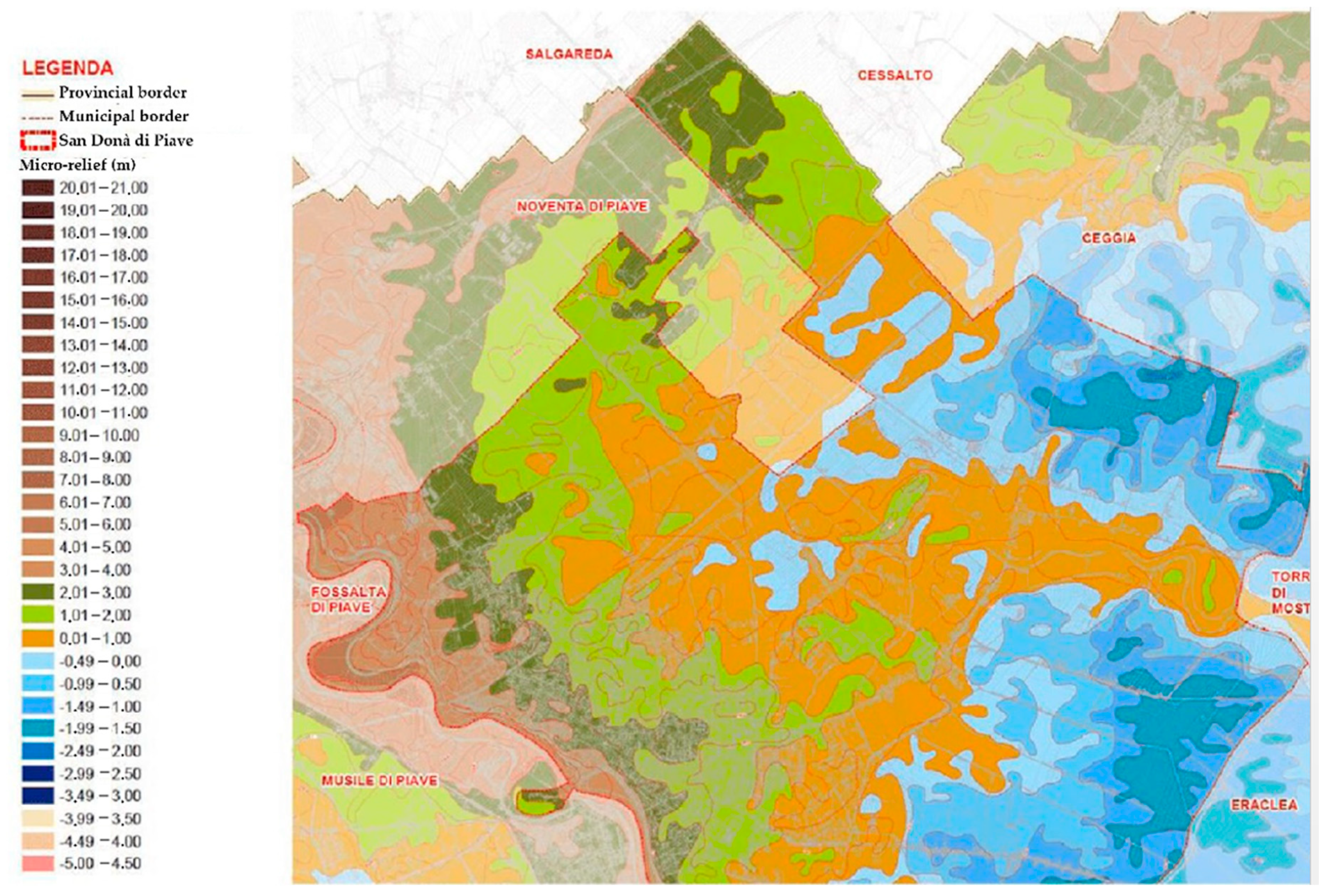
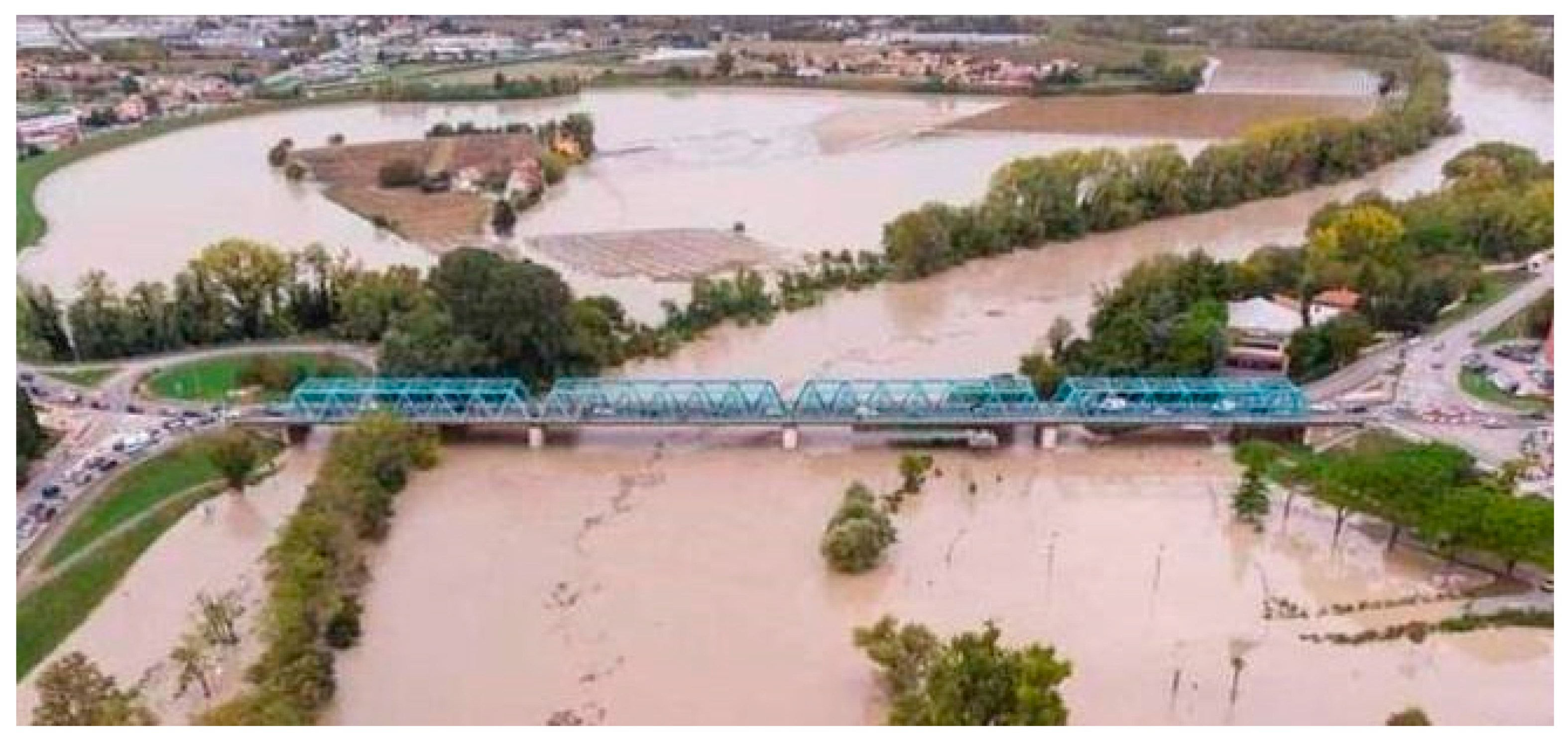
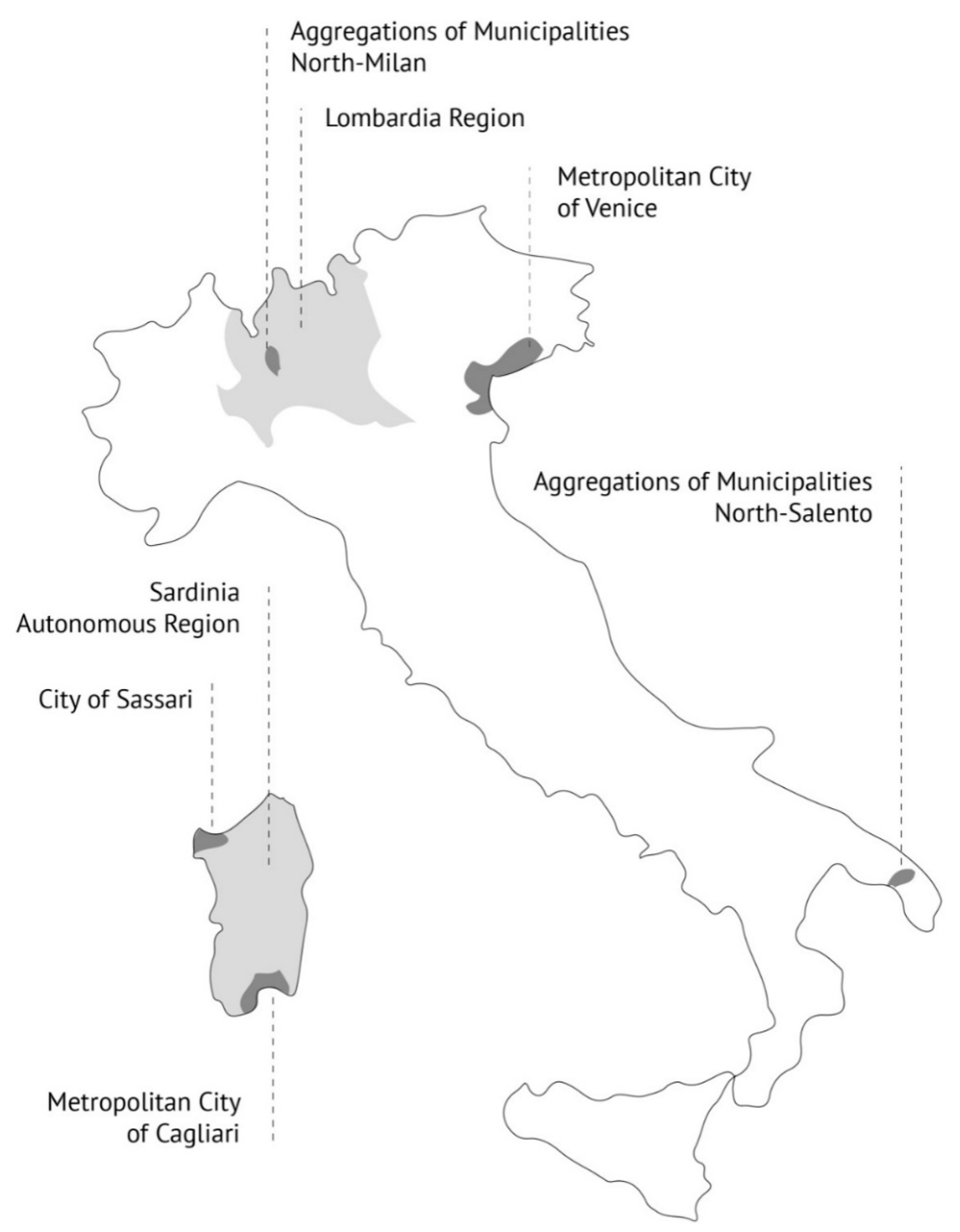
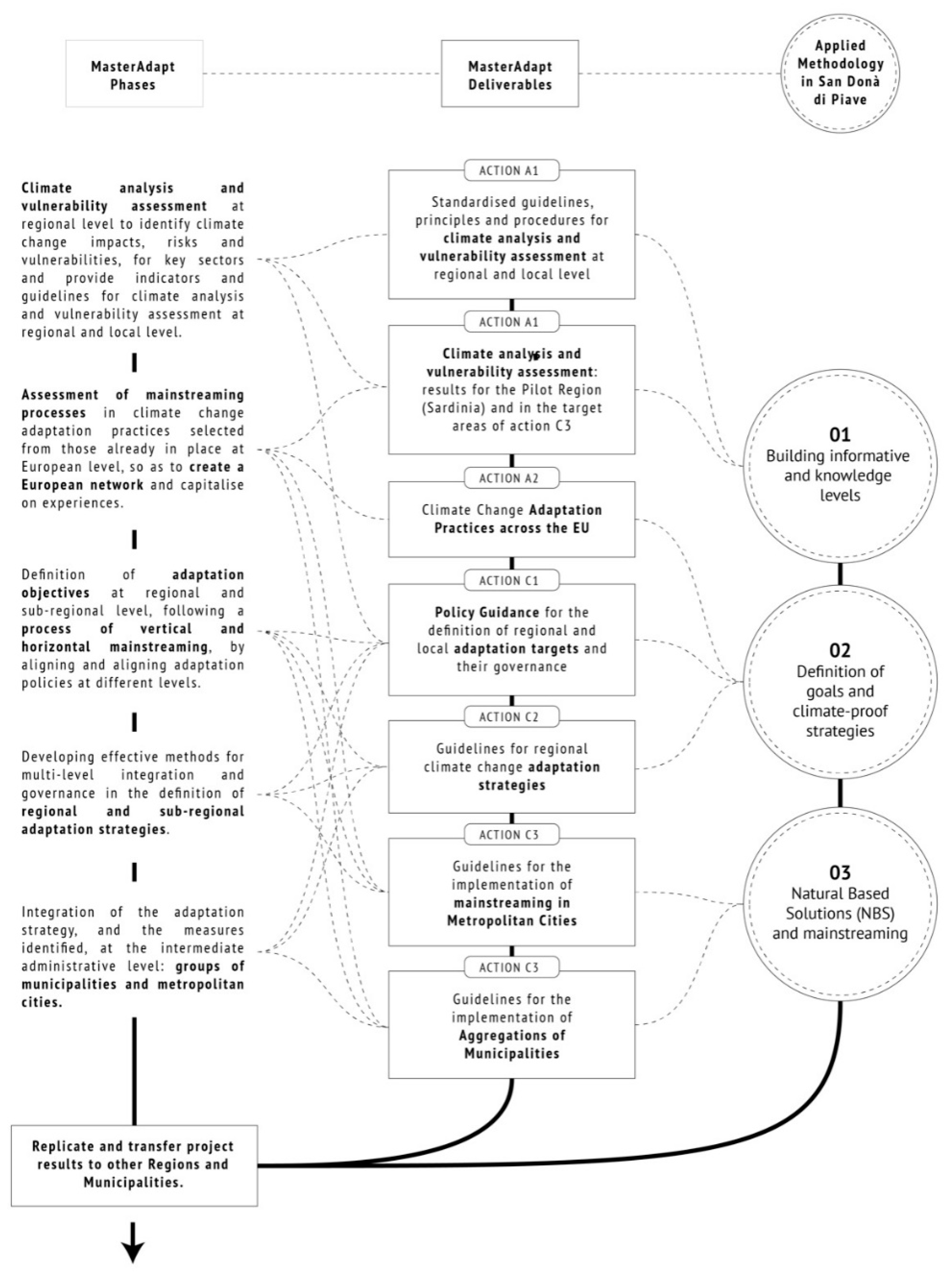
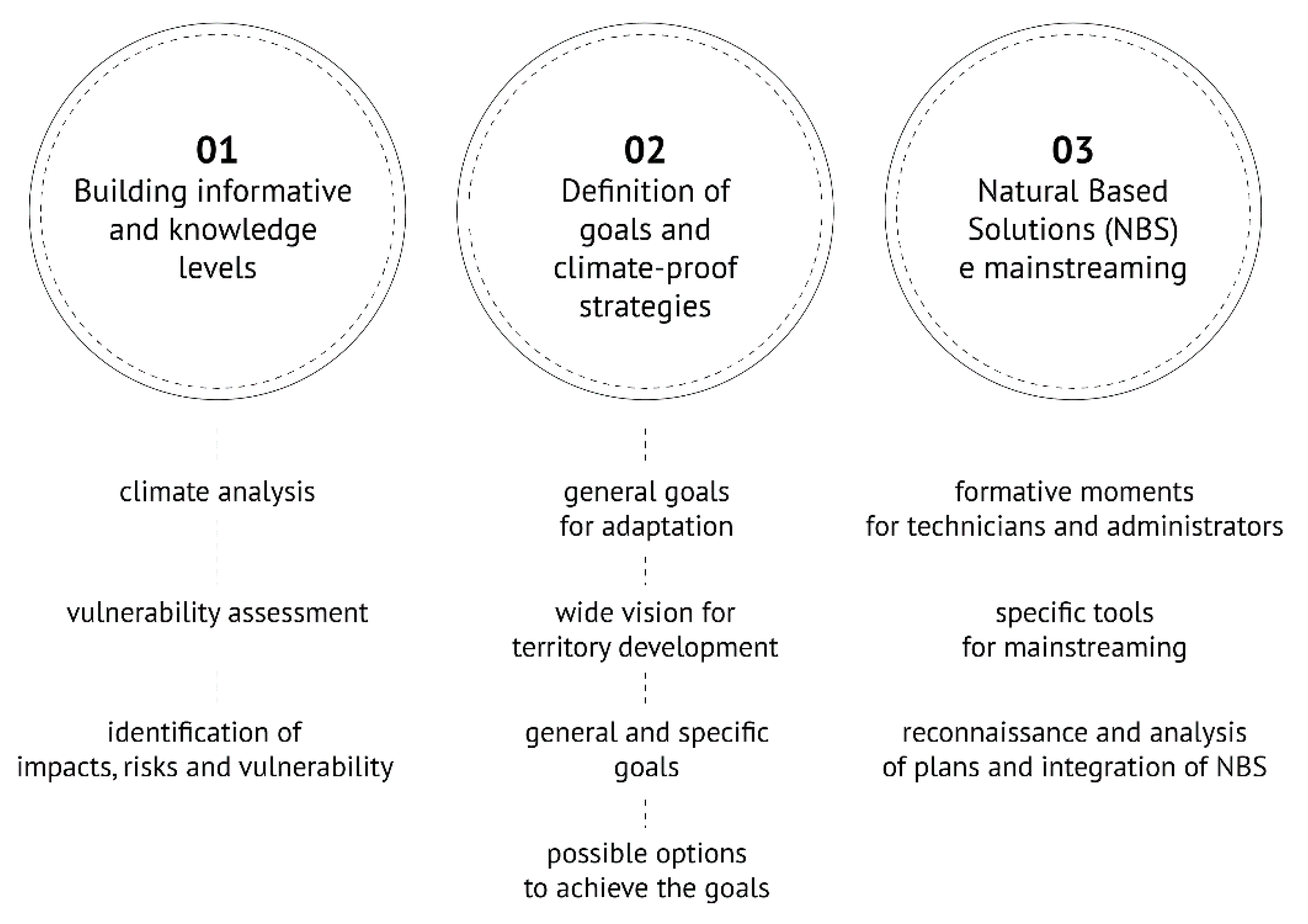
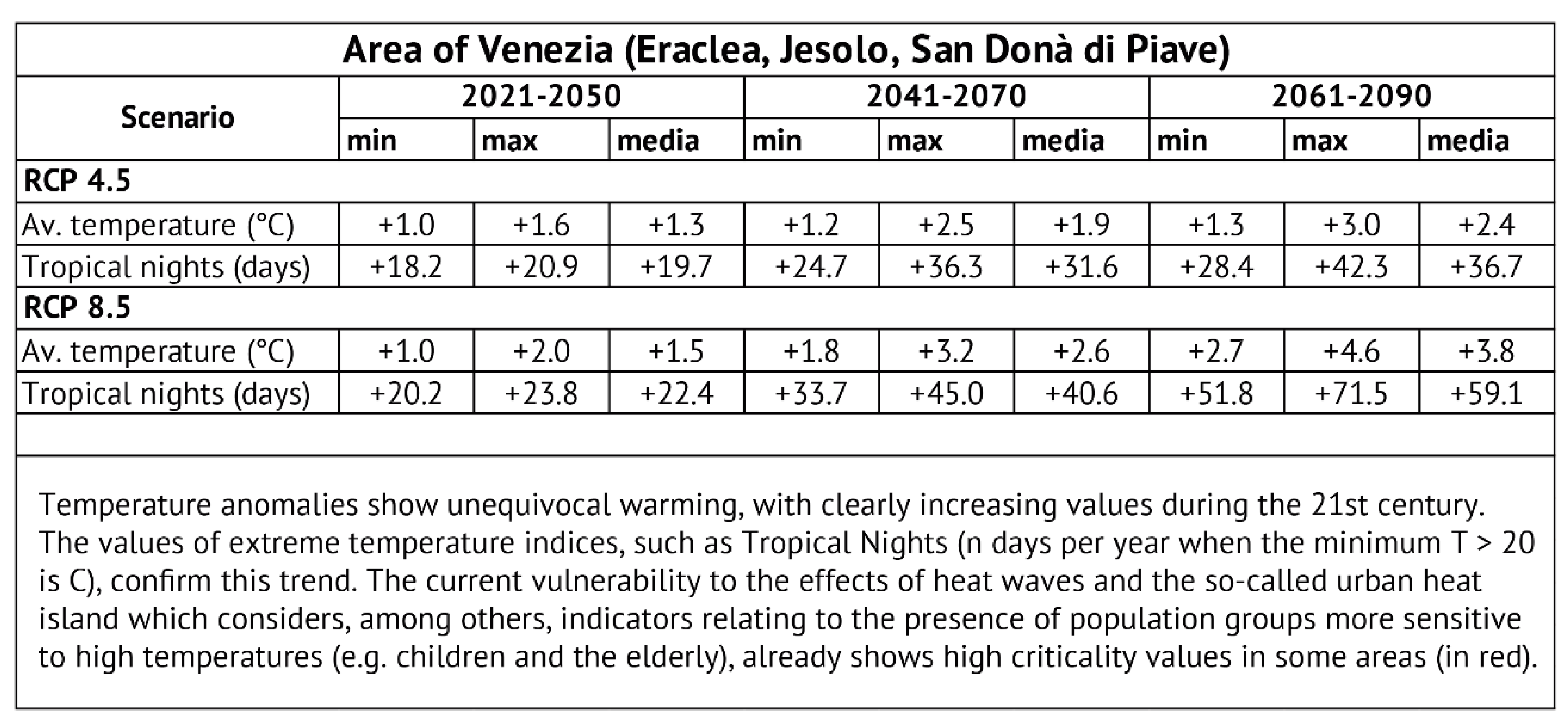
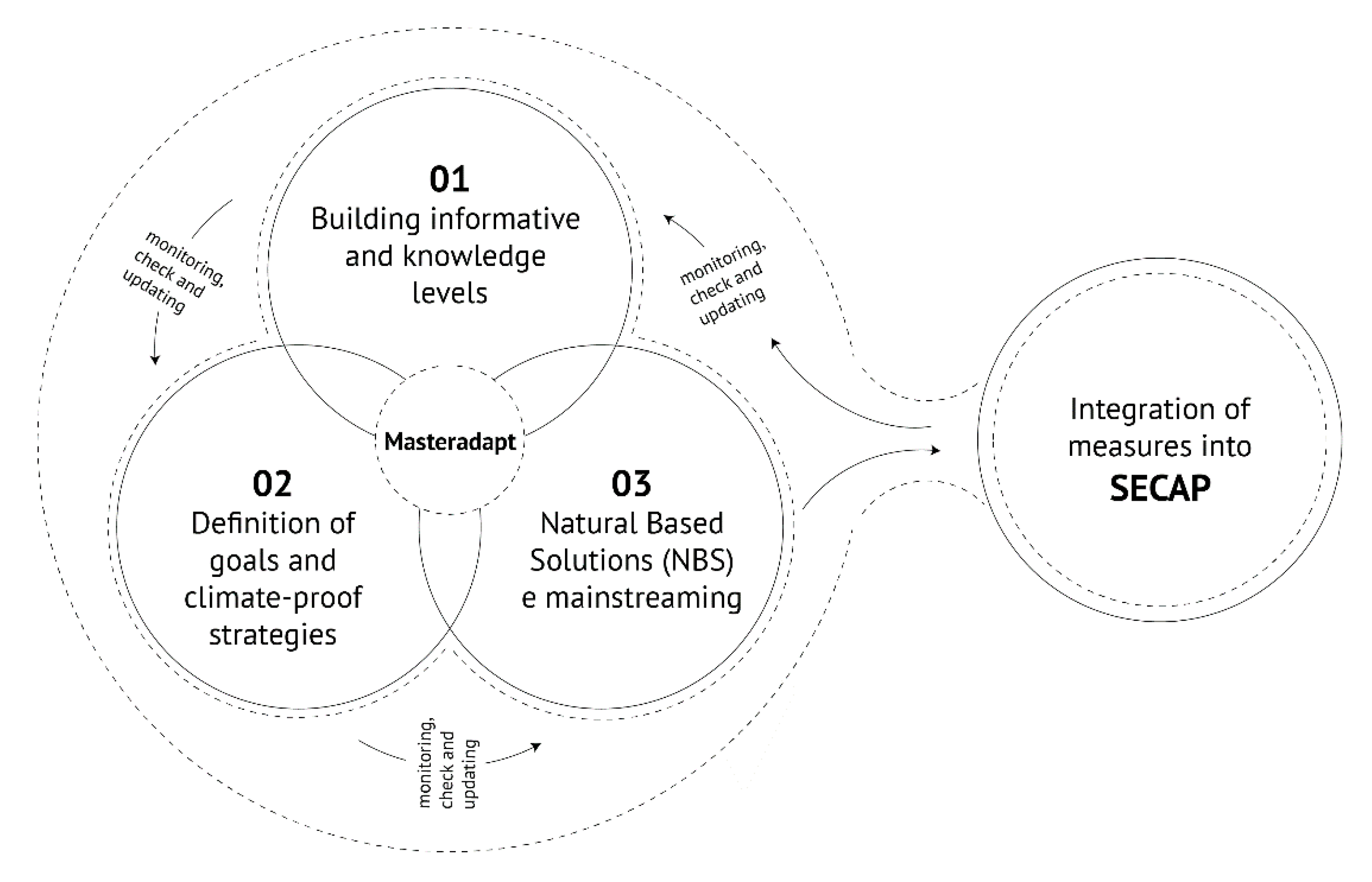
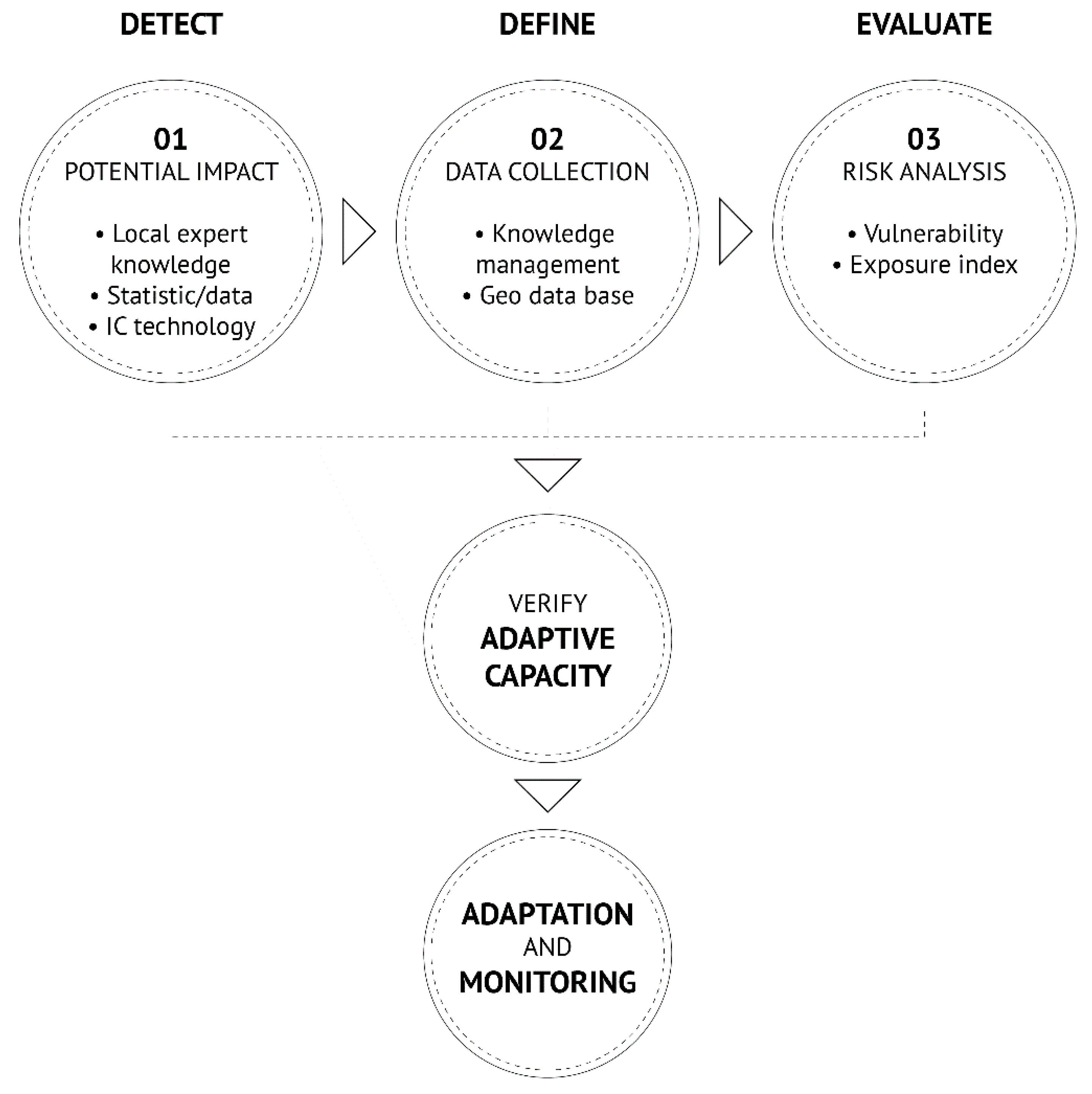
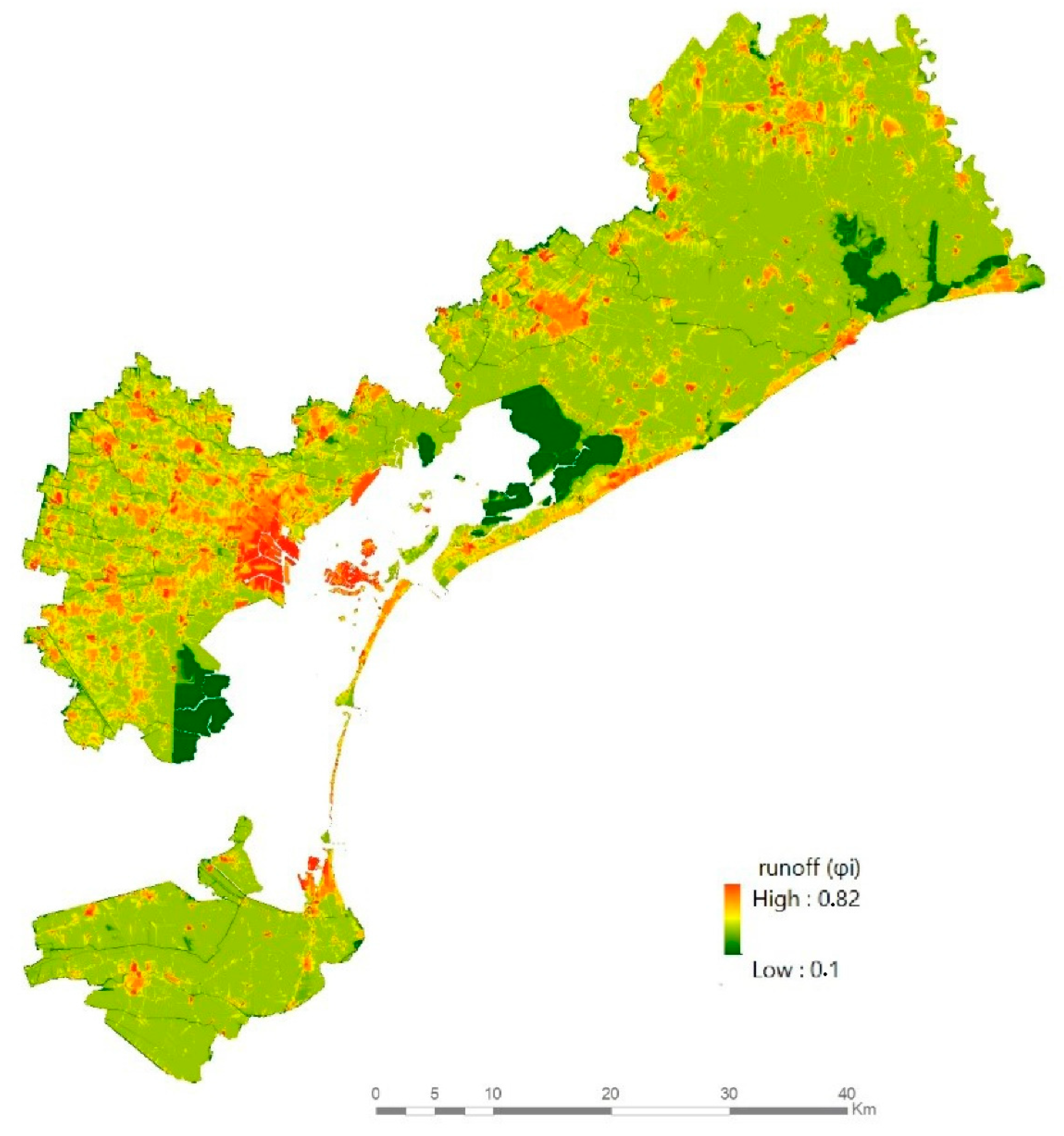
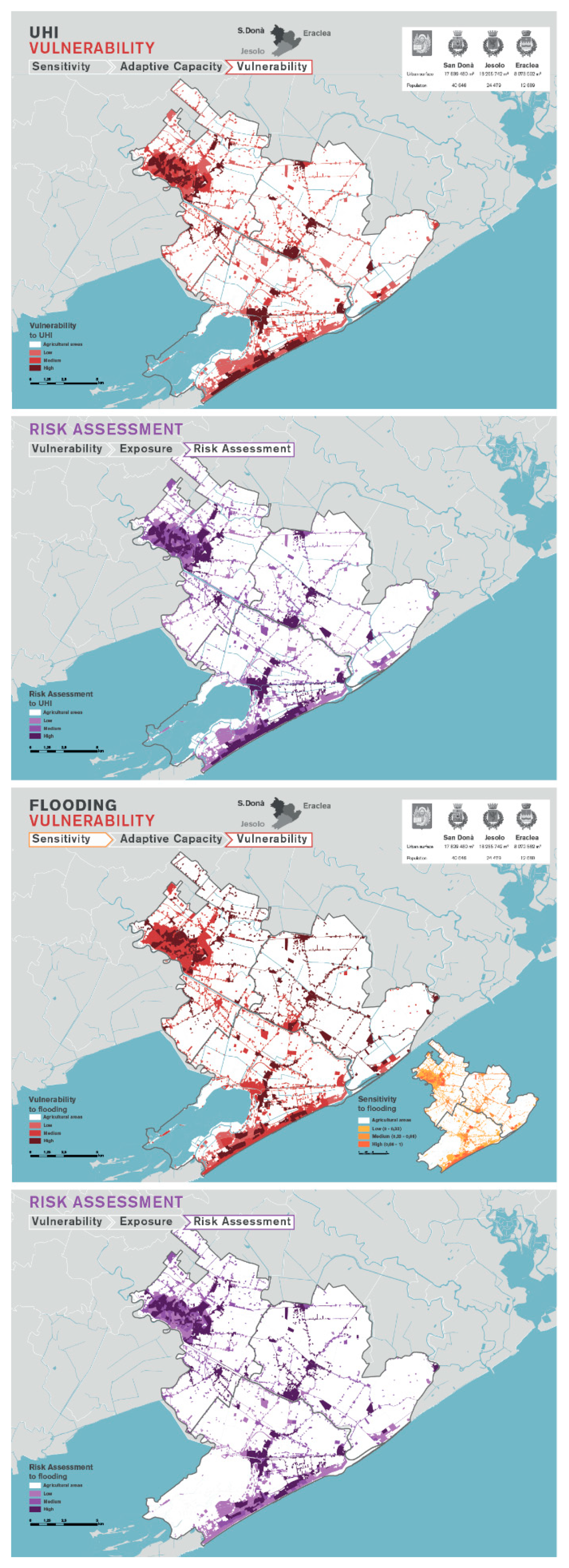
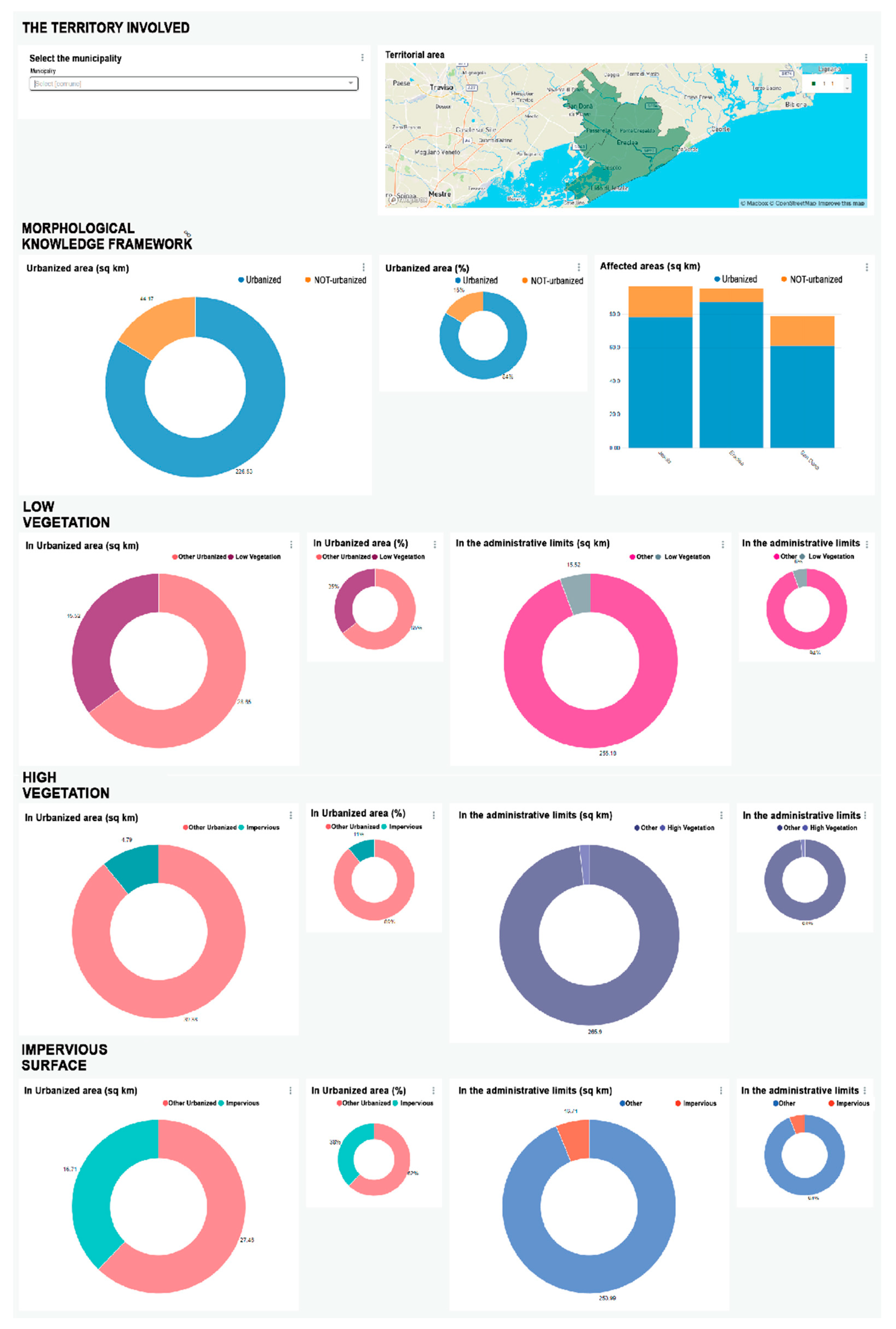
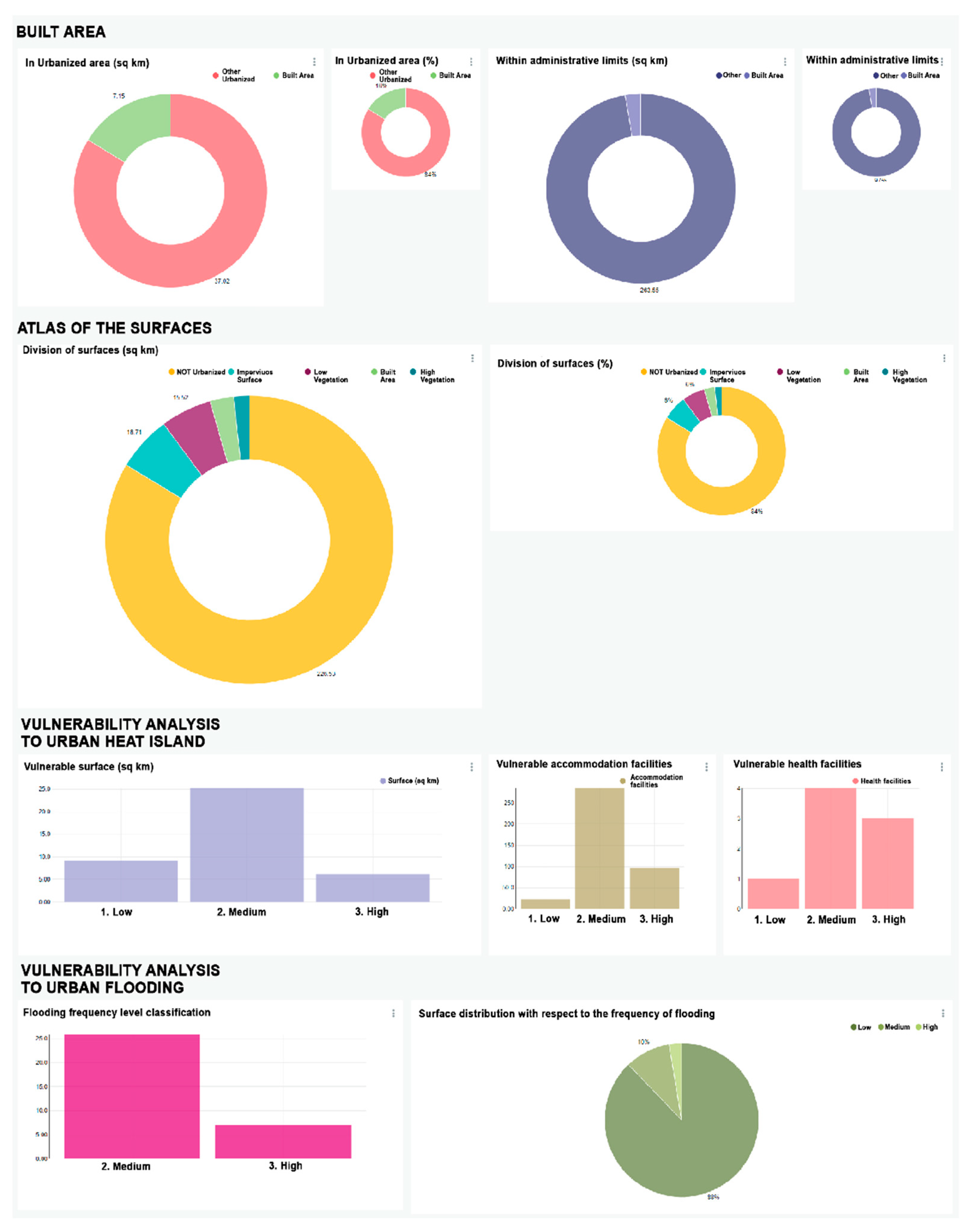
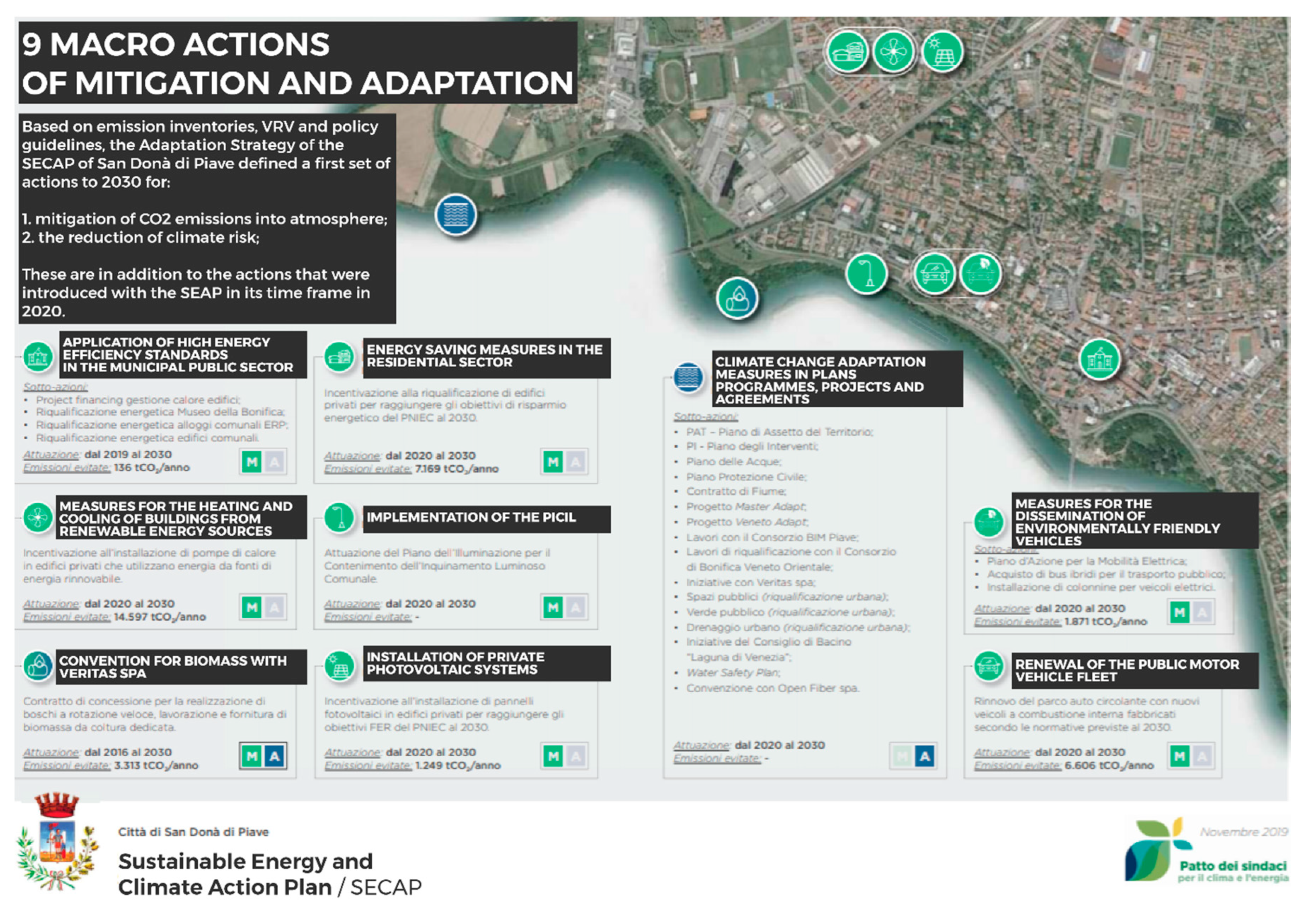
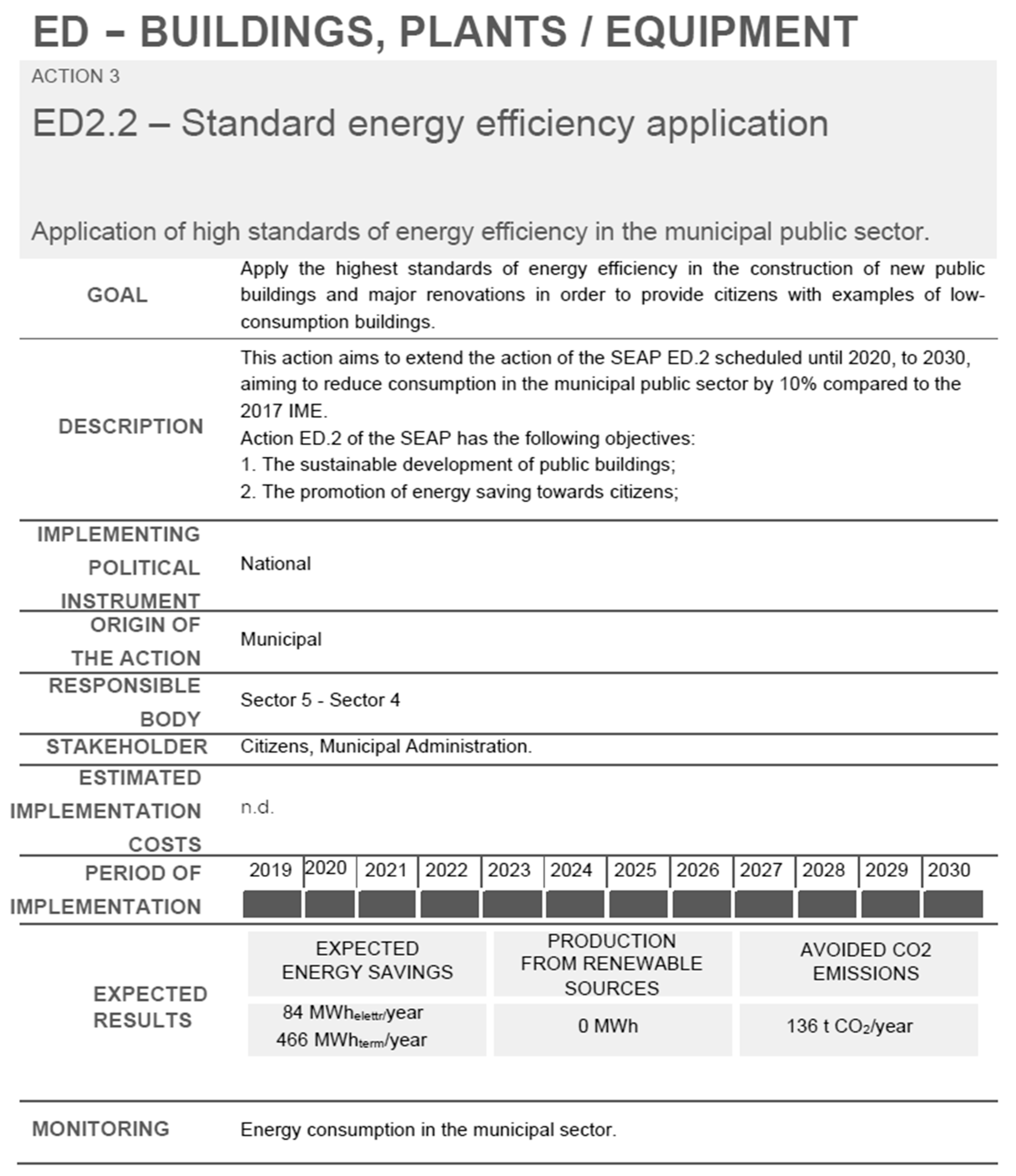
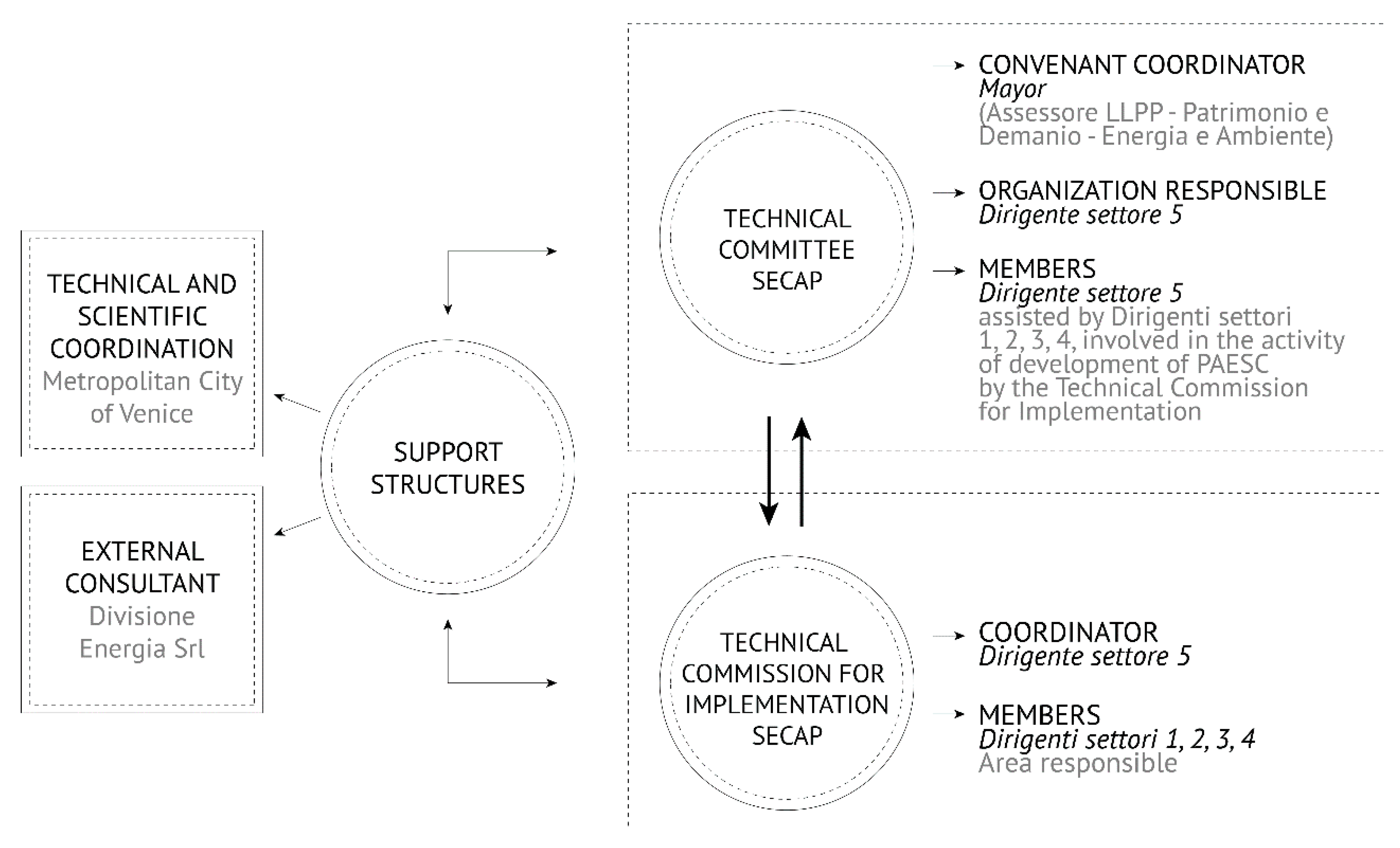
| First Meeting | Second Meeting | Third Meeting | |
|---|---|---|---|
| Date | 25 October 2018 | 31 October 2018 | 17 April 2019 |
| Title | Tools for governance and mainstreaming adaptation at local level|#1/2 | Tools for governance and mainstreaming adaptation at local level|#2/2 | Resilient metropolitan municipalities: towards adaptation to climate change |
| Place | Venice. Headquarter of Metropolitan City of Venice | Venice. Headquarter of Metropolitan City of Venice, | San Donà di Piave, Cultural Centre “da Vinci” |
| Contents | Definition of the objectives of adaptation to climate change and the development of synergies between entities necessary for the construction of an integrated plan of intervention. | Presentation of the operational methods of adaptation developed within the project networks. Confrontation on strategies and tools used. | Illustration of the Covenant of Mayors in CMVE defined the support to the municipalities in the preparation of the PAESC and preparation of the inventory of the emissions and indications on the guidelines for the transition from PAES to PAESC, explanation of adaptation and analysis of the risks and vulnerabilities of the Venice area, good practices in comparison and finally workshops with the pilot area municipalities. |
| N | Question |
|---|---|
| 01 | Are you aware of what area potentially affected by climate change is currently covered by adaptation measures? |
| 02 | If so, what is the surface? |
| 03 | Are adaptation measures planned or will be implemented at the end of the project? |
| 04 | If so, what area will be affected by these adaptation measures? |
| 05 | Are adaptation measures planned or will be implemented five years after the end of the project? |
| 06 | If so, what area will be affected by these adaptation measures? |
| 07 | Are you aware of particularly vulnerable areas in your area of expertise? |
| 08 | If so, what is the surface area of these particularly vulnerable areas? |
| 09 | Do you anticipate that at the end of the project the particularly vulnerable areas will disappear? |
| 10 | If so, by how much? |
| 11 | Do you anticipate that five years after the end of the project, particularly vulnerable areas will change? |
| 12 | If so, by how much? |
| Goals of LIFE Master Adapt, Metropolitan City of Venice | Goals of the SECAP, San Donà di Piave |
|---|---|
| Updating urban planning and design models and techniques | “Adaptation” into local and supra-municipal planning |
| The Urban Drainage; | |
| Green management | |
| Piave river management | |
| Increasing knowledge of the territory, in particular of areas subject to possible flooding | The cultural enhancement of the land reclamation |
| Raising public awareness of areas vulnerable to flooding | The exploitation of good practices in agriculture |
| Promotion of integrated coordination in the management of hydraulic risk between the different territorial policies. | Active participation in supra-municipal projects for the SEAP |
| Involvement of the territory |
| Proposed Action | Description | Tipology |
|---|---|---|
| Integration of adaptation measures climate change in plans, programs, projects and agreements | Development of integrated planning and programming tools, consistent with the SEAP’s climate change adaptation strategies and objectives, aimed at designing effective adaptation measures. | Policy |
| PAT—Spatial Planning Plan | Integrate objectives and measures to adapt to climate change into the municipality’s strategic spatial planning instrument. | Policy |
| PI—Plan of Interventions | Integrate climate change adaptation measures into the Land Planning Implementation Instrument. | Policy |
| Plan of Water | Integrating climate change adaptation measures into the water management tool of the smaller municipal network. | Policy |
| Civil Protection Plan | Develop the Civil Protection Plan with specific themes and measures for the management of risks arising from climate change to increase the security and resilience of the community. | Policy |
| River contract | Address, in an integrated and participatory way, situations of critical consequences of climate change and soil sealing levels | Policy |
| Work with the BIM Piave Consortium #1 | Increase the resilience of the territory to climate change by addressing, in an integrated way, critical situations related to the river Piave. - Management of Piave banks - Movable and fixed piers along the Piave Redevelopment works with the Consortium of Bonifica Veneto Orientale: - Channel adjustment - Renovation in pipeline and cycle path “from train to sea” - Interventions following exceptional weather events - Strengthening the urban network | Intervention |
| Work with the BIM Piave Consortium #2 | Increase the resilience of the territory to climate change through the active collaboration of the authorities of land management, thanks to initiatives and interventions connected to the network and the works of the Consortium of Reclamation Eastern Veneto. - Management of Piave banks - Movable and fixed piers along the Piave Redevelopment works with the Consortium of Bonifica Veneto Orientale: - Channel adjustment - Renovation in pipeline and cycle path “from train to sea” - Interventions following exceptional weather events - Strengthening the urban network | Intervention |
| Redevelopment work with Veritas spa for sewage treatment plants Urban redevelopment—public spaces: Porta Nuova | Collaboration with the concessionary company Veritas spa for initiatives aimed at increasing the resilience to climate change of environmental services in the territory | Intervention |
| Redevelopment work with Veritas spa for sewage treatment plants Urban redevelopment—public spaces: Porta Nuova | Increasing climate resilience through urban regeneration projects. | Intervention |
| Urban regeneration—Interventions on public green areas | Increasing resilience to climate change through urban public green regeneration projects: increasing the surface area and improving the functionality of green urban infrastructure. | Intervention |
| Urban regeneration—Urban drainage: - Pilot project The Rain Garden—Primary School Marco Polo Calvecchia - Rain garden | Drainage and management of rainwater collected on large waterproofed surfaces such as roofs, squares and roads are structural actions essential for increasing the resilience of urban areas in conjunction with weather events of particularly intense rain. The measures collected under this action relate to projects implementing the sustainable urban drainage of rainwater, capable of combating flooding, waterproofing of land and improving the collection and use of white water and the efficiency of the sewerage system | Intervention |
| Initiatives of the Council of Basin “Laguna di Venezia”:—New Plan of the Integrated Water Service | Increasing the resilience of the site to climate change through the active collaboration of land management authorities. Collaboration with the Authority of Within of the Basin “Lagoon of Venice” to increase the resilience to the climate changes of the integrated water services of the territory. Consider climate change risk factors in the assessment and management of drinking water risk across the water supply chain to contain risks to human health. | Intervention |
| Water Safety Plan | Increasing the resilience of the site to climate change through the active collaboration of land management authorities. Collaboration with the Authority of Within of the Basin “Lagoon of Venice” to increase the resilience to the climate changes of the integrated water services of the territory. Consider climate change risk factors in the assessment and management of drinking water risk across the water supply chain to contain risks to human health. | Policy |
| Concession contract for the construction of fast rotation forests, processing and supply of dedicated crop biomass. | Use of fuels from renewable energy sources to reduce net CO2 emissions to the atmosphere. | Policy |
Publisher’s Note: MDPI stays neutral with regard to jurisdictional claims in published maps and institutional affiliations. |
© 2020 by the authors. Licensee MDPI, Basel, Switzerland. This article is an open access article distributed under the terms and conditions of the Creative Commons Attribution (CC BY) license (http://creativecommons.org/licenses/by/4.0/).
Share and Cite
Magni, F.; Musco, F.; Litt, G.; Carraretto, G. The Mainstreaming of NBS in the SECAP of San Donà di Piave: The LIFE Master Adapt Methodology. Sustainability 2020, 12, 10080. https://doi.org/10.3390/su122310080
Magni F, Musco F, Litt G, Carraretto G. The Mainstreaming of NBS in the SECAP of San Donà di Piave: The LIFE Master Adapt Methodology. Sustainability. 2020; 12(23):10080. https://doi.org/10.3390/su122310080
Chicago/Turabian StyleMagni, Filippo, Francesco Musco, Giovanni Litt, and Giovanni Carraretto. 2020. "The Mainstreaming of NBS in the SECAP of San Donà di Piave: The LIFE Master Adapt Methodology" Sustainability 12, no. 23: 10080. https://doi.org/10.3390/su122310080
APA StyleMagni, F., Musco, F., Litt, G., & Carraretto, G. (2020). The Mainstreaming of NBS in the SECAP of San Donà di Piave: The LIFE Master Adapt Methodology. Sustainability, 12(23), 10080. https://doi.org/10.3390/su122310080






